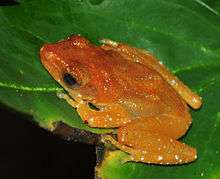Nyctixalus
Nyctixalus is a genus of frogs in the family Rhacophoridae. The common name is Indonesian tree frogs. They can be found in the Malay Peninsula, Sumatra, Java, Borneo, the Philippines, and southern Vietnam. Nyctixalus is the sister taxon of Theloderma.[1] It has also been considered subgenus of Theloderma, but the most recent research treat it as a distinct genus.[1][2]
| Nyctixalus | |
|---|---|
 | |
| Nyctixalus pictus | |
| Scientific classification | |
| Kingdom: | Animalia |
| Phylum: | Chordata |
| Class: | Amphibia |
| Order: | Anura |
| Family: | Rhacophoridae |
| Subfamily: | Rhacophorinae |
| Genus: | Nyctixalus Boulenger, 1882 |
| Species | |
|
3, see text | |
| Synonyms[1] | |
|
Hazelia Taylor, 1920 | |
Description
Nyctixalus are medium-sized frogs with adults being 30–40 mm (1.2–1.6 in) in snout–vent length. Their body and limbs have numerous spiny tubercles. Fingers are free or webbed at base. Vocal sac is always absent.[3]
Species
There are three species in the genus:[1]
- Nyctixalus margaritifer Boulenger, 1882
- Nyctixalus pictus (Peters, 1871)
- Nyctixalus spinosus (Taylor, 1920)
gollark: But in general, I would say they are "up" with regard to gravitational fields, yes.
gollark: Some of the geostationary ones are.
gollark: GTech™ orbital facilities.
gollark: Only if they use certain authentication modules.
gollark: https://httpd.apache.org/security/vulnerabilities_22.html
References
- Frost, Darrel R. (2016). "Nyctixalus Boulenger, 1882". Amphibian Species of the World: an Online Reference. Version 6.0. American Museum of Natural History. Retrieved 8 January 2017.
- Frost, Darrel R. (2016). "Theloderma Tschudi, 1838". Amphibian Species of the World: an Online Reference. Version 6.0. American Museum of Natural History. Retrieved 8 January 2017.
- Li, Jiatang; Dingqi Rao; Robert W. Murphy; Yaping Zhang (2011). "The systematic status of rhacophorid frogs" (PDF). Asian Herpetological Research. 2: 1–11. doi:10.3724/SP.J.1245.2011.00001. Archived from the original (PDF) on 2013-12-03. Retrieved 2013-11-15.
This article is issued from Wikipedia. The text is licensed under Creative Commons - Attribution - Sharealike. Additional terms may apply for the media files.